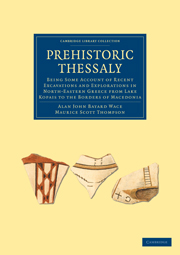 Prehistoric Thessaly
Prehistoric Thessaly Book contents
- Frontmatter
- PREFACE
- ABBREVIATIONS
- Contents
- LIST OF ILLUSTRATIONS
- INTRODUCTION
- CHAP. I THE GEOGRAPHY OF NORTH-EASTERN GREECE, AND THE DISTRIBUTION OF THE PREHISTORIC SITES
- CHAP. II THE PRINCIPAL CLASSES OF POTTERY AND CELTS
- CHAP. III NORTH THESSALY, RAKHMANI, MARMARIANI, MESIANI MAGHULA, ETC.
- CHAP. IV SOUTH EASTERN THESSALY, SESKLO, DHIMINI, PIRGHOS
- CHAP. V CENTRAL THESSALY, TSANGLI, RINI
- CHAP. VI WESTERN THESSALY, TSANI MAGHULA
- CHAP. VII SOUTHERN THESSALY, ZERELIA, PHTHIOTIC THEBES, ETC.
- CHAP. VIII THE SPERCHEUS VALLEY, LIANOKLADHI
- CHAP. IX BOEOTIA AND PHOCIS
- CHAP. X THE MYCENEAN PERIOD AND THE EARLY IRON AGE
- CHAP. XI ARCHITECTURE
- CHAP. XII CONNECTIONS WITH THE SOUTH
- CHAP. XIII CONNECTIONS WITH THE WEST
- CHAP. XIV CONNECTIONS WITH THE NORTH
- CHAP. XV CHRONOLOGY
- CHAP. XVI THE PREHISTORIC HISTORY OF NORTH-EASTERN GREECE
- CHAP. XVII ETHNOLOGICAL CONCLUSIONS
- APPENDIX I NOTES ON THE PREHISTORIC FINDS IN BULGARIA, ROUMANIA, ETC.
- APPENDIX II CHEMICAL ANALYSES, ETC.
- TABLE OF ILLUSTRATIONS REPRESENTING POTTERY
- MUSEOGRAPHICAL INDEX
- INDEX
- Plate section
CHAP. XVII - ETHNOLOGICAL CONCLUSIONS
Published online by Cambridge University Press: 07 September 2011
- Frontmatter
- PREFACE
- ABBREVIATIONS
- Contents
- LIST OF ILLUSTRATIONS
- INTRODUCTION
- CHAP. I THE GEOGRAPHY OF NORTH-EASTERN GREECE, AND THE DISTRIBUTION OF THE PREHISTORIC SITES
- CHAP. II THE PRINCIPAL CLASSES OF POTTERY AND CELTS
- CHAP. III NORTH THESSALY, RAKHMANI, MARMARIANI, MESIANI MAGHULA, ETC.
- CHAP. IV SOUTH EASTERN THESSALY, SESKLO, DHIMINI, PIRGHOS
- CHAP. V CENTRAL THESSALY, TSANGLI, RINI
- CHAP. VI WESTERN THESSALY, TSANI MAGHULA
- CHAP. VII SOUTHERN THESSALY, ZERELIA, PHTHIOTIC THEBES, ETC.
- CHAP. VIII THE SPERCHEUS VALLEY, LIANOKLADHI
- CHAP. IX BOEOTIA AND PHOCIS
- CHAP. X THE MYCENEAN PERIOD AND THE EARLY IRON AGE
- CHAP. XI ARCHITECTURE
- CHAP. XII CONNECTIONS WITH THE SOUTH
- CHAP. XIII CONNECTIONS WITH THE WEST
- CHAP. XIV CONNECTIONS WITH THE NORTH
- CHAP. XV CHRONOLOGY
- CHAP. XVI THE PREHISTORIC HISTORY OF NORTH-EASTERN GREECE
- CHAP. XVII ETHNOLOGICAL CONCLUSIONS
- APPENDIX I NOTES ON THE PREHISTORIC FINDS IN BULGARIA, ROUMANIA, ETC.
- APPENDIX II CHEMICAL ANALYSES, ETC.
- TABLE OF ILLUSTRATIONS REPRESENTING POTTERY
- MUSEOGRAPHICAL INDEX
- INDEX
- Plate section
Summary
With only scanty evidence for burial customs, and none for skull types, the ethnology of North-Eastern Greece cannot rest on a firm basis. We have seen, however, that there is a great general resemblance in culture between Thessaly and Thrace and the regions beyond. Therefore it seems highly probable that the main element in the population of North-Eastern Greece in prehistoric times had Thracian connections. From time to time this stock was doubtless strengthened by fresh incursions from the north, and in this probably lies the explanation of the appearance of spiral decoration in the Second Period. Thus we may accept Tsundas' Thracian theory in a general sense without admitting the validity of all his arguments. It seems, for example, fantastic to call in Thracians to explain the occurrence of stray figurines of a northern type at Sparta. Their early date by itself puts them probably outside the range of tradition, and similarly the suggestion that the legend of Tereus, and the Thracian war against the Minyae is based on events that took place in the First (Neolithic) Period is incredible. The tales of Thracians in Phocis and Boeotia must belong to a much later period, though probably there was always a certain Thracian element in the population of those districts.
Owing to the legends that connect Pelasgians with Thessaly, Tsundas considers that they also formed a large part of the population, and he makes them mainly responsible for the introduction of spiral decoration.
- Type
- Chapter
- Information
- Prehistoric ThessalyBeing some Account of Recent Excavations and Explorations in North-Eastern Greece from Lake Kopais to the Borders of Macedonia, pp. 250 - 256Publisher: Cambridge University PressPrint publication year: 2010First published in: 1912
